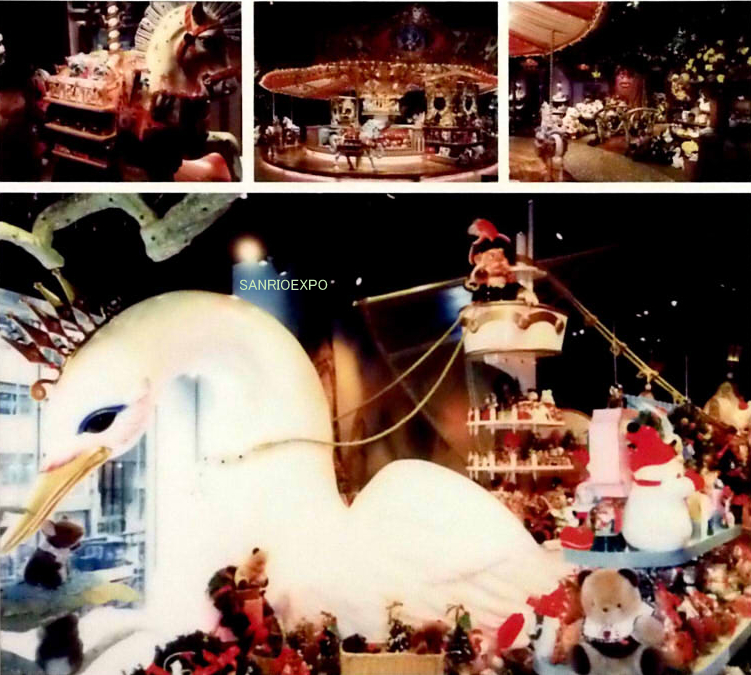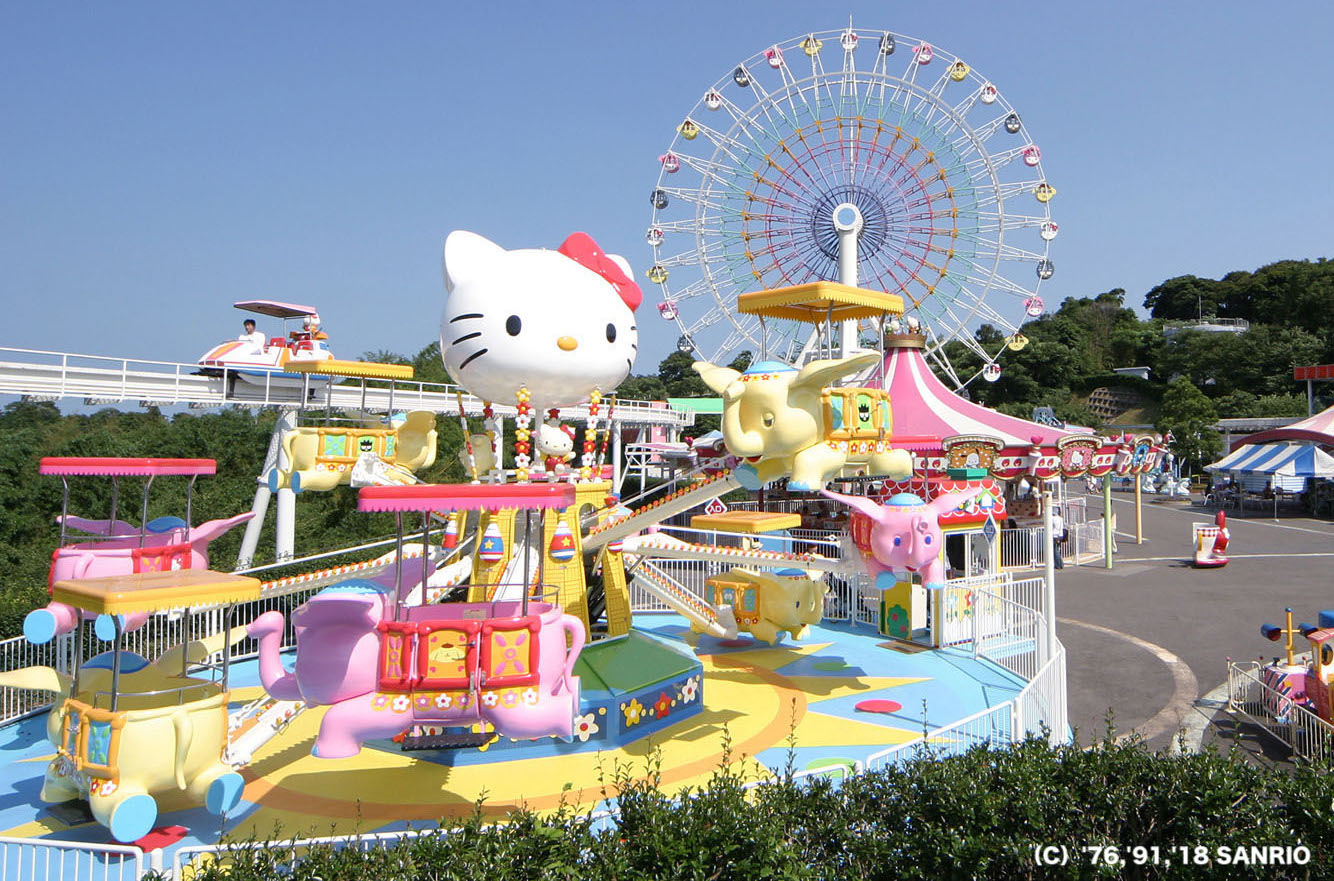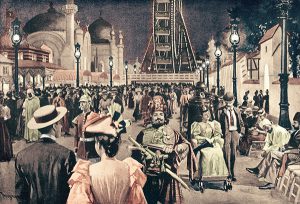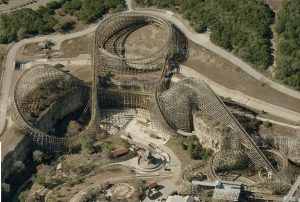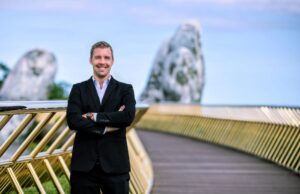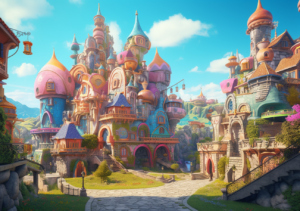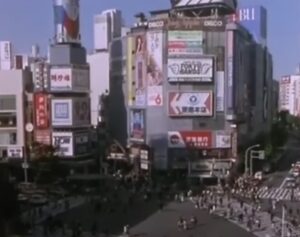Table of Contents
ToggleWon here. I had always wanted to learn about Sanrio Puroland, an indoor theme park in Tokyo opened in 1990.
In recent years multiple Hello Kitty theme parks, cafes, and other branded attractions have opened. But Puroland was the first.
The attraction has always loomed large in my imagination. It was built during Japan’s boom era and in per square foot terms, might be the most expensive theme park in history. By a long shot.
When I had the opportunity to interview legendary designer Gary Goddard, whose firm designed and project managed Puroland’s construction, I jumped at the chance.
What follows below is the transcript of a wide-ranging interview with Gary: a firsthand account of Puroland’s design and development, thoughts on what it takes to be a good theme park designer, some comments on working in Japan during the era, and more. Enjoy.
As background, by the time Mr. Tsuji, chairman of Sanrio Company, Ltd., called on Gary to design the theme park, Landmark Entertainment (Gary’s firm) had already completed a range of classic works, from the King Kong Attraction and Conan the Barbarian Show at Universal Studios Hollywood, Monster Mansion at Six Flags over Georgia, the Radio City Musical, and the Great Savannah Exposition at the Savannah History Museum.
Gary further went on to design more legendary rides and pioneer the use of 3D, like in The Amazing Adventures of Spider-man at Universal’s Islands of Adventure, and Terminator 2-3D at Universal Studios Florida.
Introduced to Sanrio
Gary: [Dentsu] had gotten rights for Sam the Eagle, which the Disney company designed for the Olympics, the mascot. But Disney would not do any turnarounds for them for animation nor would they provide a 3D maquette for them to make merchandise.
They wanted to know if we could do that? And I said, yeah, we could do that. You know, because I work with Disney animators. I knew Glenn Keane, one of the top young animators at Disney the time. He was a classmate from our college days Cal Arts. And I got Glenn Keane to moonlight and to create a walk sequence in animation of Sam the Eagle to establish his personality.
So they could have something to look at in Japan for how the character would move. And then I had one of our sculptors, I think it was Terry Cardinale – she did the 3D sculpture and maquette of Sam the Eagle for them to use for merchandising purposes.
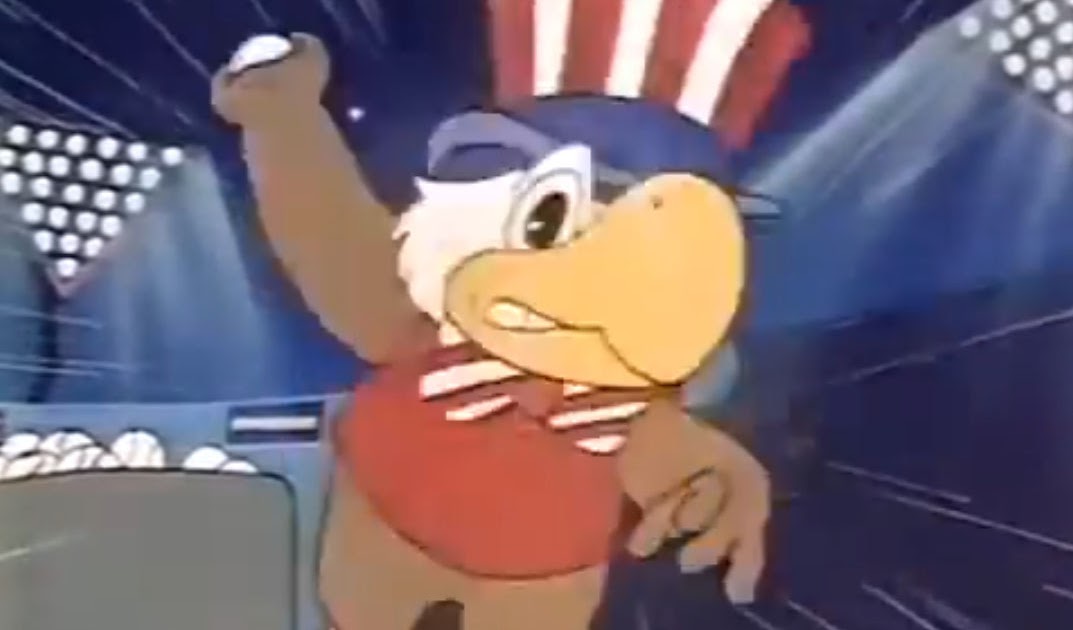
And then somehow through Dentsu, one of the guys there got our names, and then we got a contact from Sanrio in their recently opened LA office. SANRIO was interested in having someone help interpret Hello Kitty for the American market for animation.
That’s really how it started.
So we met with Sanrio’s creative team and they engaged us to do adaptations of Hello Kitty for the American market. We had industry legends like Corny Code, Rebecca Mills, Phil Mendez and others working on adapting Hello Kitty for the U.S. market. Nothing major in terms of changes, just ideas that might help to introduce her to the U.S.
And that’s how we really met Sanrio. And that got us into a few meetings with the chairman.
Then the chairman found out we did theme parks.
And he said, “oh, I want to do a retail store on the Ginza. It’s going to be two floors. We already have the property leased. And I need this to be so good that we could charge admission for people to come in.” He says, “we’re not going to charge admission, but it has to be that good.”
Can you do it? I said, yeah, we can do that. So what wound up happening was we did the second floor and their internal Sanrio designers did the first floor.
And when they opened, the second floor did all the business.
The way it was designed, there was an escalator up and down that was right by the exit to the first floor. The idea was people would come in through the main entrance on the other side, go through the first floor, then go up to the second floor, do their thing, and then come back down the escalator and make an exit. So that was the idea.
What happened was within three or four months of opening, the Ginza store became a stop for the tour buses. The tour buses would unload 60, 80 people at a time.
Within a few months, they realized that everyone wanted to go to the second floor. So the buses would drop people off at the exit, and they literally would avoid the first floor, moving right up the escalator to get to the second floor where the magic was.
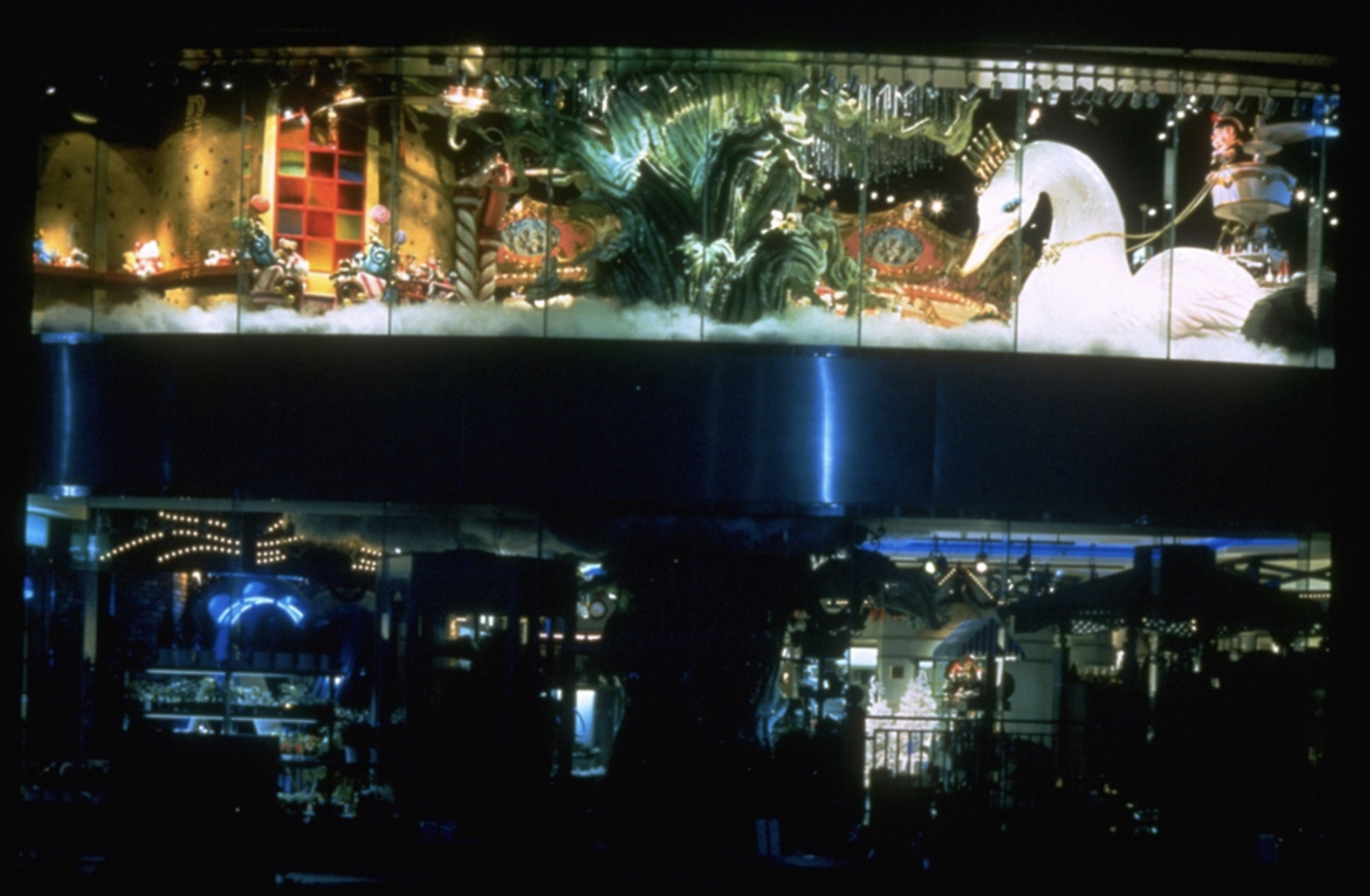
[Gary writing]: Here is GINZA GALLERY at night before we were asked to make the first floor up to the standard of the upper floor. 2nd Floor was by Landmark, first floor by the Sanrio Retail Team. Our concept DID include the BEANSTALK that you see in the center of the display window. That is because there was a massive concrete over steel support that ran right through the display windows. So since the upper floor was “FAIRYLAND” we made in in the clouds and the beanstalk grew from the area below up through the clouds into the FAIRYLAND above. The beanstalk covered a massive column that was about six feet by six feet square.
They’d just go right up to the second floor. They’d do their thing and they come back down and get on their bus.
So within the first year, Tsuji brought us back on to redo the first floor. So the first floor would have as much impact as the second floor. To be clear the 2nd Floor was generating 80% of the overall store income, the 1st floor, 20%. In usual retail set ups, the percentages are the opposite. When we re-did the first floor, it immediately started doing the same kind of numbers as the second floor.
The retail sales there were through the roof.
So he was extremely happy. Then we did one or two other things, another store at a harbor area that they had outside of Tokyo. And another small shop elsewhere in a different prefecture.
[Tsuji] said, well, this was all a test because I really want to do a theme park. And we engaged a Japanese architect firm and I don’t like what they’re doing.
And will you guys help us with this, we want you to do three attractions.
So we started out with three attractions, and then within a matter of months after we presented our attractions, Tsuji said we need to start over, you need to design the whole thing.
So that is a very short version of, you know, how we got to where we got with Mr. Tsuji. And we always dealt with Tsuji, the founder of Sanrio.
And so then we started designing. This is where the story gets interesting.

We immediately started designing what we were calling Hello Kitty Castle. We assumed Hello Kitty would be a major iconic element of this. And at some point there, as we were doing rough concepts, he put his brother-in-law in charge. Mr. Yamaguchi.
And he immediately said, no Hello Kitty. We’re like, what?
No Hello Kitty in the park. It’s going to be a new thing, a new generation. (I should note that Mr. Tsuji had earlier told me that he believed that every 30 years, if you had a company, you had to change the business. You had to grow the business. And this was going to open in their 30th year.) So this was a big deal. This theme park, which by the way, would be a massive INDOOR theme park on a relatively very small plot of land.
This was the original name they gave us, Sanrio Communication World. Okay. I said, okay, Sanrio, so what is it?
Well, we want it to be educational. I said, well, you know, okay, we could put some education in but that’s not a theme park’s business, that’s a museum’s business, but we’ll try and work some themes in.

So we started going off in this kind of strange direction for a theme park. But even so, we still assumed Hello Kitty would be central to whatever we did. This was prior to the brother in law taking over.
And we did a number of multiple exterior designs. Everyone always says, how could you design a whole park and not have a Hello Kitty? This is what were told to do. And I said to Yamaguchi one time. Is Mr. Tsuji aware of this no Hello Kitty? Oh, yeah, yeah, don’t worry. He knows everything.
Okay, so we went off in this direction and we started up a number of concepts. It was getting to be very close to construction. They started doing construction on the foundation because they knew what the property was and the local architectural firm had already had approved drawings for the building when we got involved. So infrastructure work had already been started on site. So we had to design to the facility massing structure though we could change the “cosmetics” (theming) for the exterior.
But even on the exterior “cosmetic theming” the architects were like “we have to have a design that gets approved” because they were already ordering steel and digging the huge pit for foundations. So we did another rapid fire series of exterior designs and finally got one approved. The one that you see is the one that got built. That was the one that got approved all the way up to Tsuji-san.
I was surprised that Tsuji didn’t say, you know, shouldn’t there be a little more Hello Kitty, shouldn’t there be a little more Sanrio, you know? But I think he also had “Sanrio Communication World” in mind. You can see the procession of ideas in these drawings, and these are probably 30% of the total we did.

But at that point it wasn’t ours to question. There was an intense schedule to meet. So then we were working on the attractions and same thing, no Hello Kitty, which again, surprised me. I was like, we’re not gonna have one attraction with Hello Kitty?
Now, okay, we are told by Sanrio’s people “Mr. Tsuji knows this. Yes, yes, don’t worry about it. You know, it’s okay”. So to make a long story short, a long, long, LONG story short. We went from doing three attractions to doing, of the nine attractions, we did seven and two stayed with Japanese companies.
The mansion of ghouls, which was a kind of a haunted thing, that was done by a Japanese company and one other one – The Merchan Theatre (essentially a theatre for live show presentations).
What we did come up with one the educational side. Overall we decided to divide the park into thematic zones: we came up with the idea of the Discovery Area, the Music Area, the Future Area and so on. So we tried to create a series of themes that had built into them a different set of values, different set of content, future exploration, science, music, art, those kind of things.

And there was a gigantic column in the middle that supports this huge indoor thing, right? There’s a gigantic column. Structural indoor thing, right? So that’s when we came up with the Wisdom tree. We needed something to you know, not have a gigantic column in the middle of the project. And the wisdom tree we turned into a small little walk-through attraction. So now we had a hub.
The way it was designed is another thing. Very challenging. In terms of the design, you may not realize that it’s two buildings, because Japanese codes, fire code, and all that stuff. So we had to have the entrance building, which had its own doors and fire doors and all that kind of thing. And then we had the larger building, which was the basic area with all the attractions.
So we divided the entrance area into the retail store to restaurants, things like were additional elements to the experience, not the actual entertainment experience and attractions.
And then – on the exterior entry we made that big Sanrio rainbow that you went under to discover a large open lobby with sunlight from the atrium glass arch above. And this led to the secondary arches with waterfalls on left and right. You would walk under the waterfall, through the secondary arches, and onto the escalators that took you from the first building into the second one, although you maybe don’t realize it, you’re going from one building into another right there.
That gave us a great entrance to the big building. It’s great. You come down that escalator and the whole world, the tree, everything is revealed to you. I treated it cinematically as if your eyes are like a camera craning down, and as you do, the huge expanse of the Plaza is revealed to you.
The pressure was on to get these design issues and transitions right, and they kept the work on with more attractions, five attractions, six attractions, and then we had a big meeting with to update Mr. Tsuji.
“Puro”land
Gary: Nine months, or so, maybe a year later, everything’s in progress. We’re in a big meeting. There’s the construction team, the architects. I’m presenting the overall concept. And I have my full-time interpreter next to me. This is the update for all of the work that has been going on for – as I said – somewhere between 8 or 9 months and a year.
I finished the presentation and there’s this Japanese conversation going back between Mr. Tsuji and the son-in-law (Yamaguchi), getting a little heated. What are they saying? My interpreter is quietly whispering in my ear translating things.
He’s [Mr. Tsuji] saying, “Where is Hello Kitty?” Basically, like where the hell is Hello Kitty? And #2 – he’s trying to explain that along the way we created seven new characters also for him.
So the meeting ended abruptly, and Tsuji was not happy – he didn’t blame us though. Yamaguchi explained that there would be new characters. So Yamaguchi, through the interpreters, says, we’re going to have all new characters. I say, what are they going to be? He says, you are going to design them. Ihe says he is going to think about it, and come to Los Angeles and explain his concept.
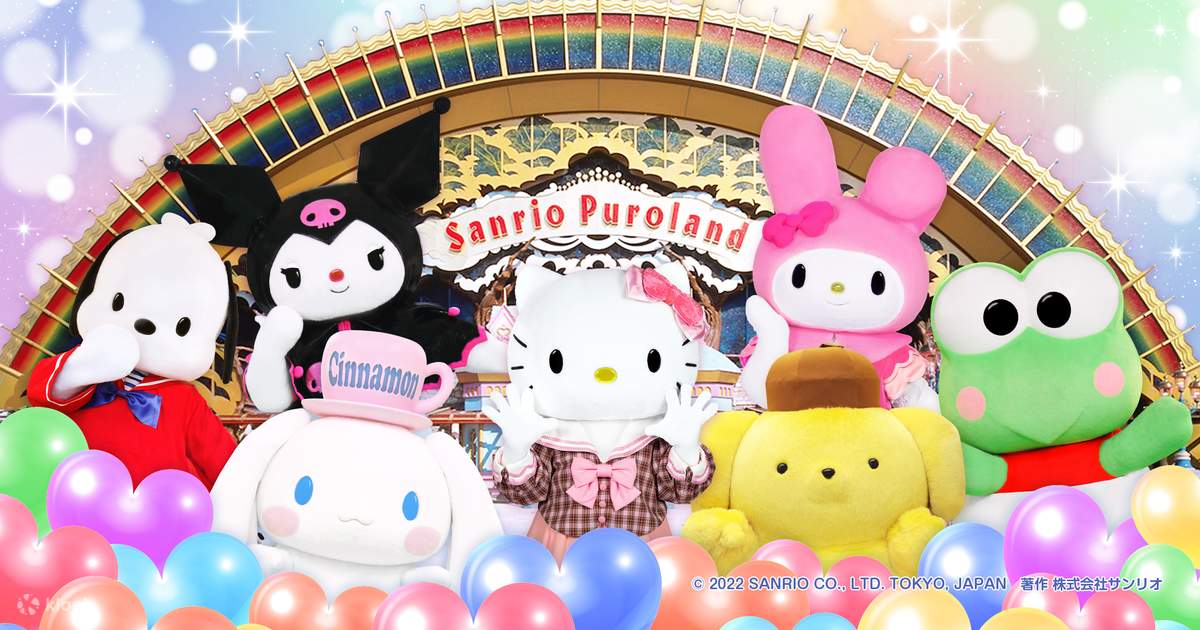
So a few weeks later, he comes to LA and we meet with him. He says he knows what the character should be now. He says, and he is speaking in Japanese, any my translator says: “They are the Janitors of the Universe.” I was kind of put off at first, and laughed lightly, but I am used to interpreting literal and figurative elements when speaking with Japanese clients, so I say – initially “ok, you mean like the French characters Peirrot & Pierrette?” He says “no, they are pure – they clean the universe.”
So I got it — like, they purify the world,—he says, yeah, yeah, yeah. But that was the initial interpretation was the janitors of the universe, they cleaned the universe.
So we started playing around with a lot of different characters, and over a period of three months or so, he didn’t like any of them. At first, we went in a direction that was a interpretation of the French Pierrot characters – but that was not what he wanterd.”
No, no. He basically said they’re ethereal. I said, do you mean they’re like, ghosts? No, not ghosts, not spirits. But eventually he came up with what he wanterd: He was describing them over the phone, The characters were going to be invisible.
No one could see them because they live in your heart.
I said, “you mean they are really invisible? They’re invisible. You don’t see them. You don’t see anything?” And he said “No, you don’t see them.”
Okay. Finally, I just said, I don’t think that’s going to work. You better run that one by Mr. Tsuji. Ultimately as I suspected, Tsuji rejected “invisible characters” and we were directed to come up with something. About that time, somewhere in there, we had created the various zones – INVENTION, MUSIC, FANTASY, FUTURE, etc, so you know, reaching for some kind of character, they said make a character for each of the lands. So, we did and ultimately came up with the PUROS, each with their own character and talent.

Won: So are these characters now in the universe, outside of the park?
Gary: I think they were at one point. I don’t know if they are anymore. That I don’t know. At one point, they merchandised them. I don’t know if they merchandised them outside of the actual theme park.
The other interesting thing about that is you have to understand two things. First, we had signed on to basically deliver all of our attractions on a date, and the opening date was December 7th,1990.
Not because of Pearl Harbor, because that happens to be coincidentally Mr. Tsuji’s birthday.
But we were already in deep, I said it’s going to be almost impossible to meet that schedule, but if– so our contract said, if your architects and your construction company deliver us dust-free conditions six months before opening, we will gear everything to that.
And I cautioned them, I did say, I don’t think you guys can get this done by that time. I mean, we experienced this a lot in Japan and Asia. “Oh, don’t worry, we’re Japanese, we all understand and we can build faster than in the U.S.”
I said it, yeah, but it’s not like we’re building an office building. This is a very different animal. But I will commit that if you will commit to have dust free, we will commit to opening the attraction on the day. And it was already a crazy schedule. But it was in the realm of do-ability. If everything went perfect, which on these projects, nothing ever goes perfect.
And the Japanese architects and engineers, they had no idea what was ahead. They, at that point, they didn’t even know what rides were, they visited a few theme parks and [said] oh, well, we know what this is, you know, we know a roller coaster, we know this.
And then the complication of doing an indoor attraction where everybody is on top of each other, it’s not like a big park where you got to turn that team there, another one over there — on an indoor project like this everyone’s on top of each other.
The architect finally fesses up and, and he and the construction manager and they go to Sanrio to say we’re not going to make their date.
Well, when ARE you going to make this date? Well, “we’re going to make this date, three months before the opening date” So we have gone from Six Months to install ALL of the shows and attractions, theming, décor, lighting, audio – etc. From SIX months to THREE.
Sanrio comes to me and says that we have to do this. There is no way that this can be done in three months.
I talked to my guys. All of our contracts had already called for shipping to arrive six months before before opening. This meant everything shipped and on site, in storage and ready to move into the facility. So, everything will be there. Lighting, audio, sound, animatronics. It will all be there and ready to be installed.
So, we put a bunch of “ifs” together. If you (SANRIO) would take care of all the shipping and import, export, you get all the stuff into a warehouse so our guys can get in the warehouse and prep everything so it can go in rapidly. Then WE (LANDMARK) will hire –essentially – THREE MEN for every ONE that would normally be engaged to install, program and deliver the final attractions. And we have an open book with you, you can see every person we hire, but we figured it out. We’re going to have to do three shifts around the clock. We’re going to have to turn six months of work into three months. What we’re going to do is hire basically three people for every job, every project manager, every art director, and we’re going to have eight-hour shifts around the clock. Take this guy and we’re going to assign him to the different attractions. And it wasn’t just attraction that but we’re responsible for everything now. The entire exterior design, the interiors, audio systems,shows and ride systems, lighting systems, everything. [We are] working with Japanese companies don’t get me wrong, but we’re selecting the equipment, we’re managing the whole process and guaranteeing opening on the origianl date.
So, Sanrio was the reason my company went from, I think, 20 or 30 people to over 280 people in the space of a year. It was crazy. So, we did it. We did a deal, open book. They approved every single salary. People always go, you made too much money. We didn’t make as much as you think because it was a ball breaker. This thing was, when you commit to something like that, you commit. You think you’ve thought of everything. You haven’t thought of it. We made them responsible for all the travel. So, we didn’t get into any of that. The travel was their issue. We get the people. You get the housing. You make sure they get back and forth. It was complicated. We had to hire six people to run the human resources department to handle all of the employees and their issues in the travel issues and coordination issues and all of that stuff.
The Scramble
Won: How long was the entire process from when they engaged you to the open?
Gary: From the very, from the very beginning, it opened in 1990, right? And we started that in, right after I finished directing Masters of the Universe ’87, in the summer. So, probably mid ’88, somewhere in there.
Won: two years to turn around the whole thing from the design to the construction and educating and training of the local team.
Gary: Yeah. And the hidden thing is, the first part was kind of easy. We did the store first. And then we just developed three attractions. That was in our wheelhouse at that moment, no problem, you know.
And then it was like, well, we need you to do two more attractions, and then one more attraction, and then another. Oh, can you help us with the overall interior design and theming, you know, Can you help us, one after another. I think we wound up having, if memory serves, 16 or 17 contracts. It wasn’t just one contract. It was a series of contracts. And most of them were always in a rush because we were taking over for whomever they contracted initially who delivered unacceptable designs.
The biggest one being the 24-hour teams for roughly three and a half, four months. Four months, because we had to have most of the team on for that. We told them, you’re going to have to keep these people on for the opening first month or so, because we’ll probably be operating everything until every is finally completely tested and adjusted. It’s crazy.

Now there’s a great story too, just to show you how much they – meaning the local architects, enigineers, and others — didn’t believe in us. Early on the architects need to know the program, which means they need to estimate weight loads, estimated power loads, estimated special systems requirements, water systems, and all of that kind of thing.
So, we had to push our attraction concepts along very hard and to track up all these estimates. We delivered the estimates. Unbeknownst to us, the electric power guys thought we were out of our minds, that the amount of electricity that we had said we were going to need was crazy. So, without telling us, what we needed would have required three generating stations – they installed one.
We didn’t know this.
Literally our opening day, the guests, the day of inviting guests and stuff. Not the real opening, but the friends and family, let’s test everything out. But there was press there.
They opened up in 20 minutes and I’m in the Wisdom Tree Plaza there by the tree. We have a brown out, not a black out, but all the lights just go down. And everyone is on walkie talkies, English, Japanese, everyone in a panic. I got my guys, you can go place to place, to the power room.
Everything is back on. Then – 20 minutes later, everything goes down again.
Everyone is there and it’s like, what’s going on? I’m trying to get answers. We got answers.
Finally, the power company had to admit that they thought our estimates were obviously amateurish and didn’t know what we’re doing.
So they had elected to install what they thought it needed, ignoring our original estimates from two years prior. I’m sure they used the basic loads for a building of that size. They had no idea what kind of power all those show and ride systems. Lighting and sound systems, and all the rest – no idea how much power they eat up.
So, they had to implement around the clock system. All of our different things had their own power meters in the power room. What was happening was whenever all the shows and attractions would hit a moment where everything was drawing power in that moment, that was causing the brown out.
So what they did was they stationed guys in there for the next six months until two more power stations could be built on site. And they would watch the monitors. Whenever they would see something peak, they would lower the power over here somewhere where it didn’t matter so it wouldn’t brown out.
For the six months, they had guys in rooms making sure the power from here would go to there and there would go to here, manually monitoring and shifting power where and when it was needed. Crazy.
So that’s kind of the backstory on everything. And the reason that we had a great contract at the end was because of that 24-hour deal, but I want to be clear, it was open book, they approved every single hire, they knew exactly what were, they knew exactly what our profit margin was, so it was like an engineering company. We’re hiring this, we’re billing you this.
The Budget
Puroland is approximately 8,000 square meters. To put its construction cost into context, Warner Bros. Abu Dhabi, which at 150,000 sqm is now the largest indoor theme park in the world, opened in 2018 with a cost of $1 billion.
Converting past amounts into current terms is always a subject of raging debate, in terms of what exchange rates to use, but for simplicity’s sake suppose we use US CPI – Puroland’s 1990 budget would be equivalent to $1.4 billion in 2018 terms. For a park 20 times smaller!
Won: I have to ask, the total budget attached to Puroland is always somewhere in the range of 500 million to a billion, is that true? Does it cost that much?
Gary: 680 million, but wait for the punchline. Do you know how the steel contracts work in Japan? Well, a lot like New York.
If you know what I am saying, there is a certain kind of group that no one talks about that controls the steel contracts. So, $680 million, $330 million was in steel.
Won: Does that entire budget also include Harmony Land, which I believe is another park?
Gary: Harmony Land was in Oita, that was an outdoor park. That was done for $330 million I believe.
Won: And then also a substantial amount in steel, I’d imagine.
Gary: Not as much because it’s an outdoor park, but yeah. That was an interesting project. Have you ever seen it? You enter up here. Imagine the entrance of Disneyland up to Main Street, but not including Main Street, is a ledge that looks down around, I would say 200 or 300 feet below the rest of the property. So everyone has to go down there and back up to this place. So, it was interesting. It was a challenging site.
We made that more of a nature park because it was out in the trees and we tried to save a lot of trees, but a lot went out. We tried to keep as many as we could and work around the them with our design.
Sanrio did not operate this. And unfortunately, I think the government took over operating it, which was all part of the original deal. They were building this for the city of Oita. That fell into disrepair pretty quick. It’s not a park that I’d point to with pride at this moment. I can still point to a few elements that still look good within the park, some of the stuff we design, but as a park, it needs six months of shutdown and let’s paint and let’s clean and let’s really fix this place up.
But Puroland has weathered the years well. That’s the other thing. In the middle of everything I just told you, with the 24 hours staffing to make the deadline, in the middle of all this – that’s when the Japanese economy hit the skids.
The one time I ever saw [Tsuji-san] kind of frantic was, because they were the middle of this project, this massive $660 million project, steel was already up. And that’s when the economy went down.
And he had to go to the banks, and he had to make some deals for them to not shut it down. Kudos to him. Somehow he kept that going and had it built.
Hello Kitty & Cultural Issues
Won: So, in terms of Puroland, is its current state basically what it was when it opened or has it changed over time?
Gary: The last time I was there was maybe four years ago, right before the pandemic. The good news is they’ve kept it pristine. It’s in great shape. And the answer to question is, essentially, it’s the same from the aesthetic point of view.
All the same places we had, theaters or theaters, same places we had shows or shows, the overall theming has remained. There are some areas with changes. But largely the Puro Village has remained constant, though rides and shows within the area have changed, but that was to be expected. Parks have to add new things, and indoor parks have no room to add “additional” rides or shows, they have to replace existing ones with new ones from time to time.
What has changed, which started within probably the year after it opened, is it’s much more Hello Kitty now. It’s much more what we would have designed, had we not had a different direction.
I didn’t tell you. When [Tsuji-san] got upset, we were told whatever to do whatever we could to add in Hello Kitty at the last minute. So, we were able to do three things.
I had worked with Larry Billman at Disney. Larry was the original writer and director of the original college Hoop-Dee-Do Wild West Dinner show at Walt Disney World. And two weeks out of Cal Arts, I was in Orlando, and served as his co-director fresh out of college. And I stayed on to do the professional casts three months later when the college kids went home, and I put all those shows on.
But Larry was a guy who did parades and stuff like that. Very quickly, I thought “can we do a PARADE with the Hello Kitty characters?” We had not designed the area for a parade since space was at a premium, but – if we could find and create a storage area for floats — mini floats that could fit on our street, not giant Rose Bowl floats. And we realized we had a ride path around the wisdom tree. People could watch a parade, right? The whole concept of Sanrio is gift giving. So, we created this parade around the spirit of giving gifts.
We can’t do a very long parade, but we can parade where six or eight floats come in and park and that’s something happens. So, I had this idea that the Hello Kitty characters would be assigned certain floats. I think we could fit either six or eight floats. And each of them would carry a present on them, a big oversized present. The first transition would be we would go from regular lighting to everything being illuminated, and our first transition to music.
So, we would have a couple of beats of the show. And as the finale, all these present boxes will open up and things will come out, characters will come out. Hello Kitty can come out. And they can give gifts to the audience. I think we did that for the first year for the kids. So we started designing this entire parade and then Larry Billman came in to supervise, I introduced him to Sanrio. And by the way he worked for them for years after. He would do all kinds. He did new parades.
And then we also proposed to take the Theater that they had, we built a theater and I said, let’s put a Hello Kitty show there. Let’s have a Hello Kitty live show on that stage. Tsuji loved all those ideas. Larry Billman also supervised the creation and staging of that live show too.
But this was the big one. Literally a year out, I mean, this was a crazy time. He said he wanted a Hello Kitty ride. One thing that I noticed there was a second level, a balcony level. And I walked the backstage area. And I said, it looks to me like we could put a small boat ride in here, or an iron ride. A little omni mover or something. I said, it’s not the greatest space in the world, but I mean, we could do it. We have to move a few beams, but it could be done.

We did some sketches, and Tsuji said do it. Everyone says, why are the boats so small? First of all, it was for moms and kids mainly, it wasn’t for a 400-pound man. And secondly, it’s all we could do, you know, and I really felt it should be a boat ride. It could fit the village more than having a train or something like that. We did think about a train.
So, then we had the challenge of trying to create this ride. But even then, we were told, because Tsuji still wasn’t involved day to day, to make it about the Puro characters, not the Hello Kitty characters.
I was like, are you sure you want to do this? This is like a boat ride. I think he [Yamaguchi] was seeing himself as the next Tsuji. Clearly he was creating his [own] characters. I think we actually had Hello Kitty as part of the ride along with the Puros.
So, anyway, we did create the Puro boat ride. And that has become the Hello Kitty ride, which it should have been. And I think they put a live show where the discovery theater is, which is another interesting thing.
The brother-in-law came to me one day with a cartoon. And it was a cartoon of Einstein, Henry Ford, and DaVinci. A cartoon like a New Yorker magazine. And they were dancing and like singing something. He goes, “we want a show like this. We want a show with great historical figures singing and dancing in a musical format. So, that’s how the whole discovery theater came about, a time machine.
And we had a little robot with a message for Japanese kids, subliminal, which is because he wanted to learn how this little robot goes through time, to learn how to be creative and each of them gives their philosophy in musical song.
We actually fulfilled this thing. We were delivering a message to the kids that you don’t have to be part of a group where everyone has to think alike. You can change, you can use your imagination and be creative and you can do that and here’s ways to do it.
Another cultural issue, which is really funny, Mr. Tsuji loved what he called fairyland. He loved fairyland. He loves gnomes, and princesses, and things like that.
So, he wants to have a fairyland. The fairyland restaurant, which my partner Tony Christopher headed up. When it came time to cast the show we had a live prince, a live princess, and a live ogre. And then we had an animatronic tree, owl, and mountain. It comes time to cast the show.
We had a meeting with Sanrio. I asked to have a meeting with Tsuji, because they said, we want you to cast an American Princess, a Caucasian Princess and Prince.
I was like, really? Are you sure? Sounds like a strange message to the kids there, if you want to be a prince and princess you have to be Caucasian?
So, I had a meeting with Tsuji. He just laughed. He’s a different generation. He said, no, no, no. No one cares about this.
It’s subliminal, I’m not saying anyone would say anything, but wouldn’t you want the prince and princess to be Japanese? And he said they have to be Caucasian, has to be white.
Okay, but I always found that disconcerting. Imagine, the prince and princess is white, and the ogre, the mountain, the evil mountain has a Japanese voice.
I was just thinking I’m a Japanese kid, the bad guys are Japanese, and the two good guys are white. And this was post WW2, we didn’t know this. We were just making movies. We were sending back in those days that the heroes were American. I don’t think we were aware. It was a different time. I was aware. But the management of Sanrio didn’t have an issue with that.
Japan in the late 80s
Won: So aside from those kinds of cultural things, what was it like working in Japan during the late 80s, because it kind of looms large in my imagination, like this insane time period when money was no object and, you know, the economy was just booming and exploding. Did you encounter any of that? Like aside from the crazy timelines and the budgets that you were given, was there anything like that stands out to you?
Gary: Well, I told all of my friends back then was, because they were in all the headlines, Japan’s going to buy America, they bought the Rockefeller Plaza, they bought the golf course in California.
And I said, you know, I’ve been over there. I’m going to tell you, Americans work harder, smarter, than the Japanese do. They stay up longer hours.
I can tell you what happens with our group. With our group, I’ll give you a great example. One of the guys, Mr. Sato, came to me and said, can you please ask your staff to leave the office by 10 o’clock? (This was obviously BEFORE the 24 hour shifts started – that came much later. This was in the earlier stages when we had about 40 people in Japan full time and others coming and going.)
Well, why? We are getting stuff done. I didn’t tell you this before. When we hired all [my] guys, they [Sanrio] hired another person for almost every single person to shadow and learn what they do. Those people would shadow my guys who were there until midnight, one a.m., they had to sit there and would be falling asleep in the office. But they stayed. They were there.
My guys had three shifts. They had three or even just two shifts. Sato said, can you please have your staff leave by 10 o’clock? They are tired. They have to be back in the morning.
I told my guys, leave the office, go to a coffee shop, chill out for 30 minutes, and then go back to do your work when no one is there. That’s what we did to get the work done.
Something else came up, that you just asked me. We were writing a thing about when Time Magazine, you know, Japan Inc. I would tell my friends, here is what I know about Japan, the more I know, the less I know. I know a lot more, it just opens up more questions than answers.
One example, we are at a meeting with the guys at one of the big companies, wasn’t the steel guy, maybe electronics, set construction. A big dinner. 6 or 8 of my guys, 10 or 12 of theirs. Everyone is drinking a little bit.
I don’t really drink so I’ve done one or two shots. And the rest I will fake because I don’t really drink. Red wine, that’s it.
At one point, they’re talking about Japan. We’re going to putdo America — Japan this, Japan that, you know. I’m like, okay.
This guy says through his interpreter, one thing about Japan, the chairman of the company only makes three times what the lowest employee makes. But in America, your chairman makes 10 or 20 or 30 times. But our chairman, he makes this.
So I say, because by now I kind of know how Japan operates and what you SEE is never the full picture here. So I say “with all due respect, how does the chairman afford a $12 million yacht if he only earns such a small amount?Because I have been on it and I know that something like that costs.”
Silence. I said, not being critical. But you can tell me he only makes three times on the books, but he’s making a lot more money elsewhere. I don’t think you are as far off as American executives. It is just done in a different way. They were shocked.
I learned about the Japanese culture. What you see in front, has nothing to do with what’s really going on.
We got along with them along very well. Tsuji would take me and my core executives out to, at that time, we’d go to the most expensive Japanese restaurants in the city. I mean, I think those dinners cost him $20,000, $30,000, $1,000 a person.
I didn’t eat sushi, they knew that. And I didn’t drink. So, the funny thing is, whenever I went out with the execs, they always knew there were shot glasses in front of my guys. But in front of me, there were two bottles of Coca-Cola. They called me the Coca-Cola kid.

